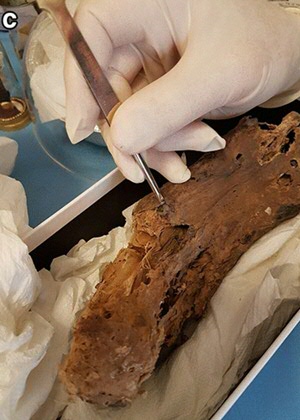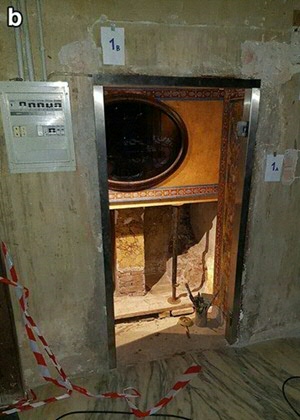Dijbeen in kerk blijkt niet van apostel Jakobus
In de Santi Apostoli-kerk in Rome liggen al sinds de zesde eeuw relikwieën die aan de apostelen Filippus en Jakobus worden toegeschreven. Het gaat om een dijbeen, een scheenbeen en een voet. Uit onderzoek blijkt dat het dijbeen, toegeschreven aan Jakobus, niet aan deze heilige heeft toebehoord, maar afkomstig is van iemand die 160 – 240 jaar later leefde. Het onderzoek illustreert daarmee eens te meer de bloeiende praktijk van gesleep met beenderen in de vroege middeleeuwen. Het onderzoek is verricht door een internationaal team wetenschappers, waaronder prof. dr. Lautaro Roig Lanzillotta (verbonden aan het KNIR te Rome) en prof.dr. Hans van der Plicht (expert op het gebied van koolstof-14 dateringen) van de RUG.

Sinds de zesde eeuw n.Chr. liggen in de Santi XII Apostoli-basiliek in Rome een aantal relikwieën, waarvan altijd is verondersteld dat het de resten zijn van twee van de vroegste christenen en apostelen van Jezus: Filippus en Jakobus (zoon van Alfeüs). Wetenschappelijke analyse werpt nieuw licht op de leeftijd en oorsprong van deze relikwieën.
Overblijfselen van martelaren
Na de eerste moeilijke eeuwen werd het christendom vanaf de vierde eeuw geleidelijk aan de dominante religie. Nadat keizer Constantijn de Grote op zijn sterfbed het christendom tot de staatsgodsdienst had uitgeroepen, werden in Rome en overal in Italië kerken gebouwd. Al snel werden overblijfselen van vereerde christelijke martelaren uit hun graven gehaald en naar deze kerken verplaatst om als relikwieën te worden vereerd. Dit gebeurde ook met de resten van de apostelen Filippus en Jakobus. Dit soort overbrengingen van de stoffelijke resten van heiligen wordt ook wel 'translatie' genoemd.
Een voet, een dijbeen en een scheenbeen
Wie de vermeende resten van Filippus en Jakobus heeft verplaatst en waar ze vandaan kwamen, weet niemand, maar feit is dat ze werden neergelegd in de Santi XII Apostoli-basiliek in Rome, die speciaal te hunner nagedachtenis was gebouwd. Ook weten we dat de resten sinds de zesde eeuw in deze kerk liggen. Maar zijn dit wel echt de overblijfselen van de apostelen Filippus en Jakobus? En wat kunnen de botten ons verder nog vertellen? De skeletten zijn lang niet meer compleet; er zijn alleen nog fragmenten van een scheenbeen, een dijbeen en een gemummificeerde voet over. Het scheenbeen en de voet worden toegeschreven aan Filippus, terwijl het dijbeen van Jakobus zou zijn. Dit wordt waarschijnlijk al sinds de zesde eeuw gedacht.

Dijbeen niet van Jakobus
De resten van Filippus bleken te lastig om te ontsmetten en dateren. Hoe oud deze relikwieën zijn, blijft dan ook vooralsnog onbekend. Het vermeende dijbeen van Jakobus kon daarentegen wel worden onderworpen aan een aantal archeometrische analyses. De belangrijkste uitkomst was die van de koolstofdatering, die uitkwam op 214-340 n.Chr. Het bewaard gebleven dijbeen is dus niet van de apostel Jakobus, maar van iemand die zo'n 160 tot 240 jaar later leefde dan hij. Wel werpt deze relikwie een klein beetje licht op een heel vroege, vrijwel ongedocumenteerde periode in de geschiedenis van het vroege christendom.
Op zoek naar overblijfselen
Wie deze persoon was, dat zullen we nooit weten. Wel is het heel waarschijnlijk dat degene die het dijbeen naar de Santi XII Apostoli-basiliek heeft overgebracht, echt geloofde dat het van Jakobus was. Deze persoon heeft het bot hoogstwaarschijnlijk uit een christelijk graf gehaald, dus het is wel degelijk een dijbeen van een vroege christen, of dit nou een apostel was of niet. Hetzelfde geldt voor de vermeende overblijfselen van Filippus. Vroege kerkelijke autoriteiten die op zoek waren naar het lijk van een apostel die al honderden jaren dood was, zochten natuurlijk vooral op oude christelijke begraafplaatsen waar de lichamen van heiligen zouden kunnen liggen, zo schrijven de onderzoekers in hun artikel in Heritage Science.

Botten verplaatsen: een populaire traditie
De eerste historisch bekende verplaatsing van het lichaam van een martelaar naar een kerk is die van Babylas van Antiochië in 354 n.Chr. Zijn stoffelijke resten werden van een begraafplaats in Antiochië overgebracht naar een kerk in de voorstad Daphne, die keizer Constantius Gallus speciaal voor dit doel had laten bouwen. Meteen daarop werd translatie populair: nog geen jaar later waren de overblijfselen van de heiligen Timoteüs, Andreas en Lucas naar Constantinopel gebracht. Vanaf de tweede helft van de vierde eeuw laten bronnen een toenemende populariteit en verspreiding van relikwieën zien. Ondanks de kritiek van bisschoppen, begon men relikwieën van martelaren en heiligen in kerken te plaatsen. In het hele Romeinse Rijk werden lichamen en lichaamsdelen opgegraven, verplaatst en in vele belangrijke kerken herbegraven in de apsis, vlak bij het altaar.
Internationaal team
Het onderzoek is verricht door de Zuid-Deense Universiteit, de Rijksuniversiteit Groningen, de Universiteit van Pisa (Italië), het Cranfield Forensic Institute in Engeland, het Italiaanse Pontificio Istituto di Archeologia Cristiana en het Deense Nationalmuseet. Als hoofdonderzoeker trad prof. Kaare Rasmussen uit Odense op. De Groningse bijdragen werden geleverd door prof. Lautaro Roig Lanzillotta van het KNIR/Faculteit Godgeleerdheid en Godsdienstwetenschap en prof. Hans van der Plicht van de Faculty of Science and Engineering, die de koolstofdatering voor zijn rekening nam.
De bevindingen zijn te lezen in het wetenschappelijke tijdschrift Heritage Science (inclusief fotomateriaal).
Contact
- Kaare Lund Rasmussen, klr@sdu.dk
- Hans van der Plicht, j.van.der.plicht@rug.nl, tel. 050-5416476
- Lautaro Roig Lanzillotta, f.l.roig.lanzillotta@rug.nl
Meer nieuws
-
19 december 2025
Mariano Méndez ontvangt Argentijnse RAÍCES-prijs
-
18 december 2025
Waarom innoveren, en voor wie?
-
17 december 2025
Ben Feringa wint Feynmanprijs
